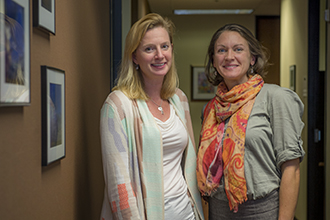Living in disordered neighborhoods gets under the skin
Living in a violence-plagued neighborhood may cause such great stress that a person's gene expression may be altered. These are the findings of Katherine Theall, Stacy Drury and an interdisciplinary team of Tulane University researchers.

Katherine Theall, right, and Stacy Drury investigate the effects of stressful environments on children. They are part of the recently organized Tulane University Stress and Environment Research Collaborative for Health Disparities. (Photo by Paula Burch-Celentano)
Theall is associate professor of global community health and behavioral sciences at the School of Public Health and Tropical Medicine, and Drury is assistant professor of psychiatry in the School of Medicine.
In their recently conducted study, the co-investigators found that in a group of children, ages 4â“15, more than 50 percent had experienced at least one life adversity, including witnessing some form of violence.
While psychological distress among the children would be expected, Theall says, “The exposure to violence also was associated with physiologic, internal stress.”
Theall refers to this stress as that which gets “under the skin.”
The researchers took saliva samples of the children to gather data on the length of the children's telomeres. Telomere length is a cellular marker of aging and a potential marker of stress exposure. In kids who had experienced more violence and lived in more disordered neighborhoods, telomere length was shorter than in children who lived in more stable environments.
Theall is leading researchers from public health, medicine, science and engineering and social work in the Tulane Stress and Environment Research Collaborative for Health Disparities, which has lab space in the newly renovated J. Bennett Johnston Building.
Taking a “transdisciplinary” approach, the researchers are exploring how stress is biologically and behaviorally embedded to influence health. This is stress in the broadest sense community, interpersonal and individual. They are looking at critical periods in utero, early infancy, childhood and adolescence when exposure to stressors may matter most.
“If we could take our work, overall, or project by project,” says Theall, “and use it to influence positive changes, whether policy in the neighborhood environment or how we think about parenting and early childhood education, that would be the biggest accomplishment.”
